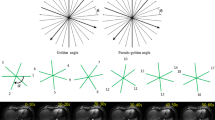Abstract
Purpose
The purpose of this study is to quantitatively compare the accuracy of spatial registration of Cartesian breath-hold 3D-GRE and non-respiratory-triggered free-breathing radial 3D-GRE images with PET data acquisition on whole-body hybrid MR–PET system.
Materials and methods
Eight patients (six men and two women; mean age, 56.6 ± 5.5 years) with nine ablated hepatocellular carcinomas constituted our study population. Spatial coordinates (x, y, z) of the estimated isocenters of the ablated areas were independently determined by two radiologists. Both T1-weighted sequences were performed in the axial plane. Distance between the isocenter of the lesion on PET images and on both T1-weighted images was measured, and misregistration was calculated. Statistical analysis was performed using Student t test.
Results
Misalignment values of the hepatic ablation zones between PET and MR images were calculated at 4.94 ± 1.35 mm (reader 1) and 4.89 ± 2.21 mm (reader 2) for Cartesian 3D-GRE sequence, and 2.48 ± 0.65 mm (reader 1) and 2.72 ± 0.44 mm (reader 2) for the radial 3D-GRE sequence, with p values of 0.0011 and 0.0133, respectively.
Conclusion
Radial 3D-GRE offers improved registration accuracy with PET, supporting the use of this T1-weighted sequence in upper abdominal MR–PET studies.


Similar content being viewed by others
References
Osman MM, Cohade C, Nakamoto Y, et al. (2003) Clinically significant inaccurate localization of lesions with PET/CT: frequency in 300 patients. J Nucl Med 44:240–243
Seppenwoolde Y, Shirato H, Kitamura K, et al. (2002) Precise and real-time measurement of 3D tumor motion in lung due to breathing and heartbeat, measured during radiotherapy. Int J Radiat Oncol Biol Phys 53:822–834
Nakamoto Y, Chin BB, Cohade C, et al. (2004) PET/CT: artifacts caused by bowel motion. Nucl Med Commun 25:221–225
Erdi YE, Nehmeh SA, Pan T, et al. (2004) The CT motion quantitation of lung lesions and its impact on PET-measured SUVs. J Nucl Med 45:1287–1292
Guerin B, Cho S, Chun SY, et al. (2011) Nonrigid PET motion compensation in the lower abdomen using simultaneous tagged-MRI and PET imaging. Med Phys 38:3025–3038
Cohade C, Osman M, Marshall LNT, Wahl RNTL (2003) PET-CT: accuracy of PET and CT spatial registration of lung lesions. Eur J Nucl Med Mol Imaging 30:721–726. doi:10.1007/s00259-002-1055-3
Wurslin C, Schmidt H, Martirosian P, et al. (2013) Respiratory motion correction in oncologic PET using T1-weighted MR imaging on a simultaneous whole-body PET/MR system. J Nucl Med 54:464–471. doi:10.2967/jnumed.112.105296
Rofsky NM, Lee VS, Laub G, et al. (1999) Abdominal MR imaging with a volumetric interpolated breath-hold examination. Radiology 212:876–884. doi:10.1148/radiology.212.3.r99se34876
Reiner CS, Neville AM, Nazeer HK, et al. (2013) Contrast-enhanced free-breathing 3D T1-weighted gradient-echo sequence for hepatobiliary MRI in patients with breath-holding difficulties. Eur Radiol 23:3087–3093. doi:10.1007/s00330-013-2910-2
Azevedo RM, de Campos ROP, Ramalho M, et al. (2011) Free-breathing 3D T1-weighted gradient-echo sequence with radial data sampling in abdominal MRI: preliminary observations. Am J Roentgenol 197:650–657. doi:10.2214/AJR.10.5881
Schwenzer NF, Schmidt H, Claussen CD (2012) Whole-body MR/PET: applications in abdominal imaging. Abdom Imaging 37:20–28. doi:10.1007/s00261-011-9809-7
Schwarz AJ, Leach MO (2000) Implications of respiratory motion for the quantification of 2D MR spectroscopic imaging data in the abdomen. Phys Med Biol 45:2105–2116
Dawood M, Buther F, Stegger L, et al. (2009) Optimal number of respiratory gates in positron emission tomography: a cardiac patient study. Med Phys 36:1775–1784
Suramo I, Paivansalo M, Myllyla V (1984) Cranio-caudal movements of the liver, pancreas and kidneys in respiration. Acta Radiol Diagn (Stockh) 25:129–131
Grimm R, Fürst S, Dregely I, et al. (2013) Self-gated radial MRI for respiratory motion compensation on hybrid PET/MR systems. Med Image Comput Comput Assist Interv 16:17–24
Judenhofer MS, Cherry SR (2013) Applications for preclinical PET/MRI. Semin Nucl Med 43:19–29. doi:10.1053/j.semnuclmed.2012.08.004
Slomka PJ, Dey D, Przetak C, Aladl UE, Baum RP (2003) Automated 3-dimensional registration of stand-alone (18)F-FDG whole-body PET with CT. J Nucl Med 44:1156–1167
Forster GJ, Laumann C, Nickel O, et al. (2003) SPET/CT image co-registration in the abdomen with a simple and cost-effective tool. Eur J Nucl Med Mol Imaging 30:32–39. doi:10.1007/s00259-002-1013-0
Fin L, Daouk J, Morvan J, et al. (2008) Initial clinical results for breath-hold CT-based processing of respiratory-gated PET acquisitions. Eur J Nucl Med Mol Imaging 35:1971–1980. doi:10.1007/s00259-008-0858-2
Fin L, Daouk J, Bailly P, et al. (2012) Improved imaging of intrahepatic colorectal metastases with 18F-fluorodeoxyglucose respiratory-gated positron emission tomography. Nucl Med Commun 33:656–662. doi:10.1097/MNM.0b013e328351fce8
Daouk J, Leloire M, Fin L, et al. (2011) Respiratory-gated 18F-FDG PET imaging in lung cancer: effects on sensitivity and specificity. Acta Radiol 52:651–657. doi:10.1258/ar.2011.110018
Chang G, Chang T, Pan T, Clark JWJ, Mawlawi OR (2010) Implementation of an automated respiratory amplitude gating technique for PET/CT: clinical evaluation. J Nucl Med 51:16–24. doi:10.2967/jnumed.109.068759
Kuhn J-P, Holmes JH, Brau ACS, et al. (2013) Navigator flip angle optimization for free-breathing T1-weighted hepatobiliary phase imaging with gadoxetic acid. J Magn Reson Imaging . doi:10.1002/jmri.24480
Nagle SK, Busse RF, Brau AC, et al. (2012) High resolution navigated three-dimensional T(1)-weighted hepatobiliary MRI using gadoxetic acid optimized for 1.5 Tesla. J Magn Reson Imaging 36:890–899. doi:10.1002/jmri.23713
Lee ES, Lee JM, Yu MH, et al. (2014) High spatial resolution, respiratory-gated, t1-weighted magnetic resonance imaging of the liver and the biliary tract during the hepatobiliary phase of gadoxetic Acid-enhanced magnetic resonance imaging. J Comput Assist Tomogr 38:360–366. doi:10.1097/RCT.0000000000000055
Brendle CB, Schmidt H, Fleischer S, et al. (2013) Simultaneously acquired MR/PET images compared with sequential MR/PET and PET/CT: alignment quality. Radiology 268:190–199. doi:10.1148/radiol.13121838
Rakheja R, DeMello L, Chandarana H, et al. (2013) Comparison of the accuracy of PET/CT and PET/MRI spatial registration of multiple metastatic lesions. Am J Roentgenol 201:1120–1123. doi:10.2214/AJR.13.11305
Author information
Authors and Affiliations
Corresponding author
Rights and permissions
About this article
Cite this article
Ramalho, M., AlObaidy, M., Burke, L.M. et al. MR–PET co-registration in upper abdominal imaging: quantitative comparison of two different T1-weighted gradient echo sequences: initial observations. Abdom Imaging 40, 1426–1431 (2015). https://doi.org/10.1007/s00261-015-0460-6
Published:
Issue Date:
DOI: https://doi.org/10.1007/s00261-015-0460-6




